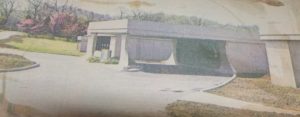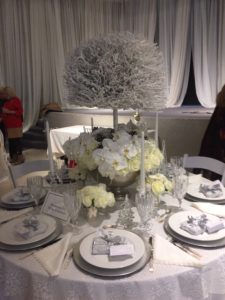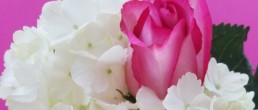History of the Horticultural Society of Middle Tennessee
It was most likely a flower show that created the catalyst initiating the formation of the Horticultural Society of Davidson County. The 1930 Flower Show was chaired by Mrs. James C. Frasier. The following year on March 13, 1931 she called the initial meeting and Mrs. W. B. Herbert recorded the minutes. The constitution and bylaws met approval, having been previously drafted by a committee appointed by Mrs. Fraser. The funds from the 1930 Flower Show, a balance of $257.90 was carried forward to the society’s new treasury. Mrs. Jesse H. Overton was unanimously elected President and the Horticultural Society of Davidson County was founded.
Meetings were to be held the second Wednesday of June and December in the Hermitage Hotel Loggia with the Flower Show scheduled on May 12-13, 1931 at the War Memorial Building. It raised $660.90 and was on the scale of a modern-day Lawn and Garden Show. The founding member clubs were Garden Club of Nashville, Capital GC, Town and Country GC, Belle Meade GC, Belmont GC, Deer Park GC, Garden Lovers GC, and Lebanon Road GC. Charter members were Harpeth Valley GC, Waverly GC, Four Corners GC, Harding Road GC, Blue Hills GC, Garden Study Club, and the Iris, Dahlia, and Gladiola Clubs. Many of these are still members today!
The early focus set a precedent for the many years to come. Strategies to promote civic improvements, beautification of state highways, and the preservation of wildlife and native plants, as well as flower shows with emphasis on horticulture rather than architecture were implemented. In 1932 the Society planted elm and hackberry trees on the grounds of every school in Davidson County in honor of the bicentennial of George Washington’s birthday.
 They offered a prize for the most attractively planted filling station. By 1934 in conjunction with the Iris Association they had transformed Nashville into the “Iris City of the World” for the National Iris Society Meeting. That same year they planted dogwoods and magnolias around Nashville. During the Christmas season they boycotted vendors of native evergreens in a move to protect wildlife and initiated a writing campaign to Congress to fight the spread of the Dutch Elm Beetle. Of the estimated 77 million elms in North America in 1930, over 75% had been lost by 1989.
They offered a prize for the most attractively planted filling station. By 1934 in conjunction with the Iris Association they had transformed Nashville into the “Iris City of the World” for the National Iris Society Meeting. That same year they planted dogwoods and magnolias around Nashville. During the Christmas season they boycotted vendors of native evergreens in a move to protect wildlife and initiated a writing campaign to Congress to fight the spread of the Dutch Elm Beetle. Of the estimated 77 million elms in North America in 1930, over 75% had been lost by 1989.
Beginning with the 1922 Flower Show, The Society arranged tours of private gardens as a courtesy to visiting judges and guest. This tradition continued throughout the years until 1940 when the Garden Tour formerly conducted by the ladies of West End Methodist Church was added as a fund-raising event. By the time it halted for the War in 1943 the Pilgrimage had grown from four gardens in 1940 to forty gardens and twelve homes raising $2,676.75. Coca Cola and General Outdoor Advertising Company were tour sponsors.
In 1945 the Society helped plan and restore the old city cemetery with the Historical Society. This project continues today under the direction of the Master Gardeners of Davidson County. In 1946 the Society became a founding sponsor of the Nashville Children’s Museum donating $767.76. It was to be used for a permanent exhibition of native Tennessee wild flowers executed in wax. The flowers represented were recommended by the Society.
The HANDS Project (Home and Neighborhood Development Sponsors), a citywide beautification and conservation program was initiated in 1958. It was funded in part by the Sears Foundation and received numerous awards and accolades including the 1975 and 1976 Awards of Excellence. Activities included school clean-up campaigns, landscaping of public buildings, schools, and parks, including a park at Fort Nashborough for the Bicentennial. Throughout the years the Society has produced many outstanding Flower Shows that have won State and National awards. The Community Flower Show started in 1996 continues at Cheekwood every two years in May of even years.
Not long after its creation, the Horticultural Society of Davidson County maintained a gardening library in Tom Harrison’s Flower Shop on West End Avenue. After an association with Sears was formed in 1956 with the construction of its new downtown store, the library was moved. Sears incorporated a gardening center staffed with volunteers. The garden clubs sponsored weekly flower shows and the HANDS project, now consisting of clubs throughout the southeastern US, was headquartered there as well. In addition to office and library space, Sears provided a meeting venue and gave an annual grant of $1,000 to the Horticultural Society.
A few years later, Cheekwood, originally built as the home of Leslie and Mabel Cheek in 1929, was converted into a museum of art and botanical garden. The Horticultural Society was one of three founding entities and moved their office to the Cheekwood Mansion that year in 1960.
The tradition of “Trees of Christmas” began in 1964 when the Horticultural Society presented “Christmas Trees of Many Lands” in the Cheekwood Mansion for the benefit of a botanic complex. Over 35,000 attended each year in what became one of Nashville’s most popular traditions. A Memorial Fund for Mrs. Jesse Overton was also established in 1964. Annual donations to the general fund, furnishings for Botanic Hall, scholarships, equipment, library, and payments on building indebtedness were part of this fund.
When plans were drawn for Botanic Hall in 1970, the Society donated the first $100,000 toward the building. Then upon its compl etion they provided the final payment of $3,500. A business office was included in the building that HSMT still maintains today. The building dedication took place May 2, 1971 with the Atrium dedicated to Mrs. Jesse Overton as the founder of the Horticultural Society. Subsequently, the Horticultural Society’s library, which had been located at Sears, was donated to Cheekwood and “Trees of Christmas” was moved from the mansion into Botanic Hall. Since 1965 proceeds from the “Trees of Christmas” exhibits along with a variety of other fund-raising events presented to Cheekwood are in excess of $2,575,000. The funds have been used for display greenhouses, maintenance of Botanic Hall, the Gardens and contributions to the general operating expenses of Cheekwood.
etion they provided the final payment of $3,500. A business office was included in the building that HSMT still maintains today. The building dedication took place May 2, 1971 with the Atrium dedicated to Mrs. Jesse Overton as the founder of the Horticultural Society. Subsequently, the Horticultural Society’s library, which had been located at Sears, was donated to Cheekwood and “Trees of Christmas” was moved from the mansion into Botanic Hall. Since 1965 proceeds from the “Trees of Christmas” exhibits along with a variety of other fund-raising events presented to Cheekwood are in excess of $2,575,000. The funds have been used for display greenhouses, maintenance of Botanic Hall, the Gardens and contributions to the general operating expenses of Cheekwood.
By 1997, 61 garden clubs comprised a membership of approximately 1500. The continual growth of the Horticultural Society in the surrounding area prompted the name change to the Horticultural Society of Middle Tennessee. The Horticultural Society currently enjoys the association of clubs not only in Davidson County but also Williamson, Wilson, Montgomery, Maury, Bedford, Giles, Sumner, and Rutherford counties. Also in 1997, the membership voted to establish an Auxiliary Membership category for those who did not belong to a garden club but were interested in participating in HSMT activities and events.
HSMT’s 1998 special project was to landscape and plant a garden at the YWCA headquarters in commemoration of its centennial year.
Major changes were made by Cheekwood in 2002 to the 36-year tradition of “Trees of Christmas”. HSMT moved its fundraising direction to a variety of activities that included the Angel Dinner, Holiday Magic, Breakfast with Santa, Frog Frolic, Summer Supper, Sparkling Settings, Fall Harvest Dinner, and Martinis and Mistletoe.
Martinis and Mistletoe, a festive cocktail party for the younger generation after Thanksgiving; and Sparkling Settings, a Holiday Luncheon and Silent Auction hosted by our garden clubs offer a variety of opportunities for all generations to become involved with the Horticultural Society of Middle Tennessee. In addition, we hold three general membership meetings a year with an assortment of speakers and luncheons. We would like to invite you to join us either as a member of HSMT, through one of our garden clubs, or as a guest at one or all our garden celebration events.

Today, 93 years after its founding, Horticultural Society of Middle Tennessee is still actively involved with the garden clubs and societies all around the area. Many newer clubs have been established over the years participating alongside long standing ones. To find a garden club in your area look on our How to Join/Start a Garden Club Page. If you would like to start your own garden club, we have many mentors who are willing to assist you with that as well.
